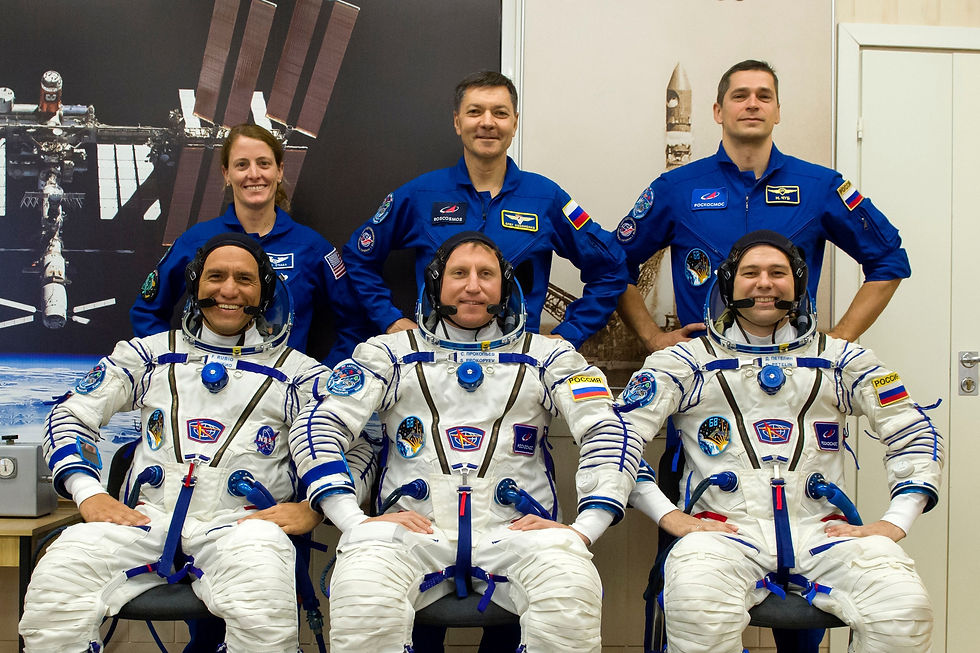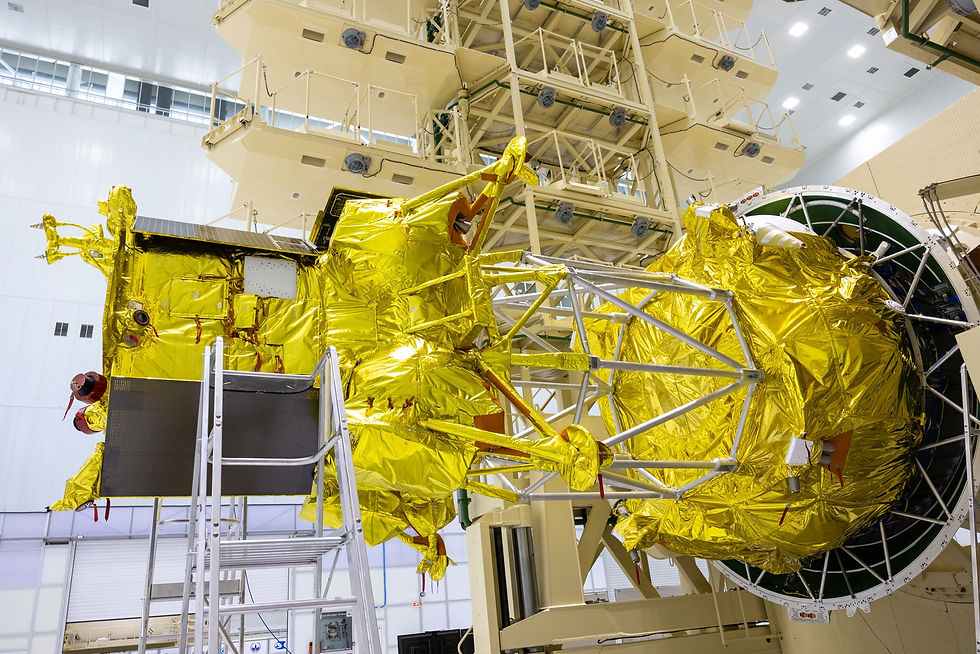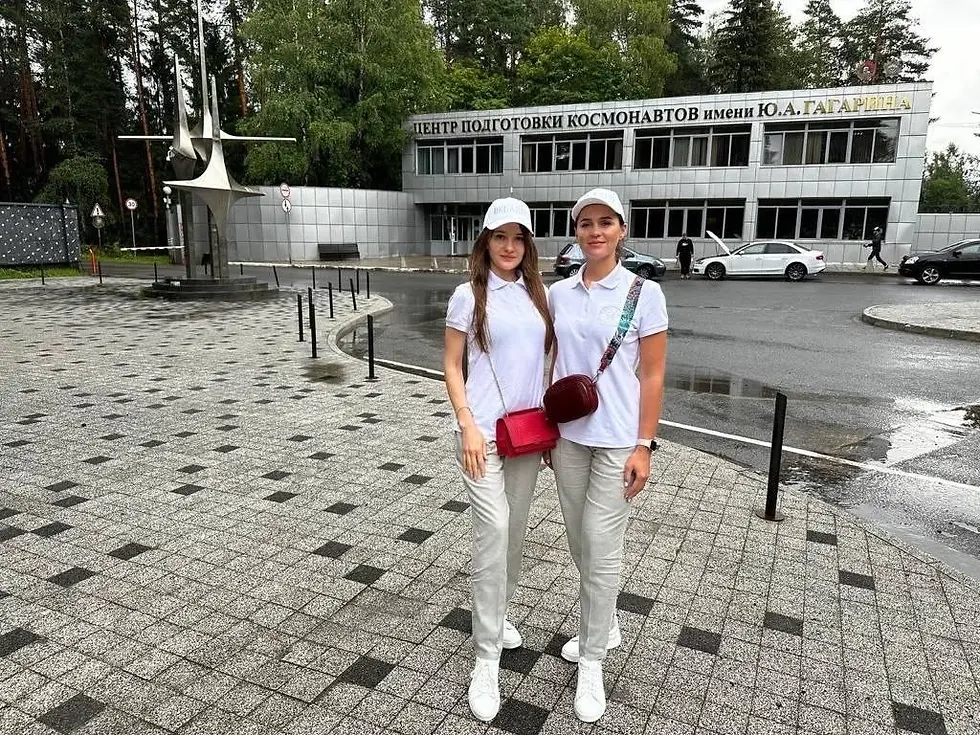Roscosmos launches Soyuz MS-22
- Karthik Naren
- Sep 22, 2022
- 6 min read
Spacecraft docked with the space station with two Russians and an American Astronaut

The Soyuz-2.1a rocket with the Soyuz MS-22 spacecraft carrying the 68th expedition to the International Space Station successfully took off on September 21, 2022 at 16:54:49 Moscow time (09:54:49.531 EDT) from the Baikonur Cosmodrome. The main crew of the spacecraft (11F732A48 #751) is made up of Commander Sergei Prokopiev, Flight Engineer-1 Dmitry Petelin, a native of Kazakhstan – Roscosmos – and Flight Engineer-2 Frank Rubio, from NASA. After a standard three-hour flight, the spacecraft docked with the Russian module Rassvet.

The Soyuz docked with Rassvet at around 1:11 pm EDT (1711 UTC) after a two-orbit flight. About two hours after docking, the hatches between the Soyuz and the space station officially opened at 3:34 pm EDT. The arrival of three new crew members to the seven existing people aboard Expedition 67 temporarily increases the station's population to ten. Astronaut Rubio and cosmonauts Prokopyev and Petelin joined Expedition 67 – Commander Oleg Artemyev, Roscosmos cosmonauts Denis Matveev and Sergey Korsakov, NASA astronauts Bob Hines, Kjell Lindgren and Jessica Watkins, and European Space Agency astronaut Samantha Cristoforetti. Rubio, Prokopyev and Petelin will spend six months aboard the orbiting laboratory.
Soyuz MS-22 delivered to the ISS sanitary and hygienic supplies and medical control, on-board documentation and consumable items for service equipment, clothing and personal belongings of the cosmonauts, rations and fresh food, as well as packaging for experiments the Econ-M scientists, Biofilm, Interaction-2, Biomag-M, MSK-2, FAGEN, Cardiovector, Cytomechanarium and Reflex. The first experiments with the Russian 3D printer will be brought to Earth by the crew of the Soyuz MS-21.

Expedition 67 astronauts – Hines, Lindgren, Watkins and Cristoforetti have been aboard since their arrival in April on the SpaceX Dragon Crew-4 Freedom . Freedom and her crew are currently planning to return in early to mid-October.
MS-22 Crew

Cosmonaut Prokopiev said he would take his daughter's jewelry and grandson's cross with him on the flight to remind him of his family as he works at the station. "First of all, these are my daughter's jewelry and my grandson's cross, these are the things that will warm my heart," Prokopiev told a news conference. Prokopiev was born on February 19, 1975 and became a grandfather in 2021. He clarified that crews often carry personal belongings, photos of friends and relatives. His crewmate Dmitry Petelin decided to take his eldest daughter's drawings with him, as well as a talisman that her grandfather used in World War II. American astronaut Rubio takes family photos and small objects of his children that “will be a nice gift” when he returns home.
Homage to the pioneer Tsiolkovsky

The spacecraft was named Tsiolkovsky in honor of the 165th anniversary of the birth of Konstantin Tsiolkovsky, Russian scientist, inventor, and founder of space exploration theory. The rocket's head fairing bears a portrait of the scientist and the inscription “165 years since the birth of Konstantin Tsiolkovsky. The crew emblem is made in the form of a circle. At the top are applied: the crew's call sign, “Altai”, and the flags of the countries participating in the flight (Russia on the left, the USA on the right). In the same field below, the names of the expedition members are entered. At the top of the inner circle is presented: at the top a stylized image of the station, and at the bottom an image of the spacecraft. Underneath the spacecraft is the name and serial number of the Soyuz MS-22 spacecraft, whose flight direction points to the ISS. Below is an image of Earth. The ISS is surrounded by three stars, corresponding to the number of crew members on the spacecraft. The swan symbolizes the crew commander, Colonel of the Aerospace Forces of the Russian Federation Prokopiev, who flew Tu-160 aircraft during his military service – which Russian pilots call the “White Swan”. To the right of the three stars is a stylized image of a turtle, symbolizing the name of the 2017 NASA astronaut ensemble, the Turtles, of which Franco Rubio is a member. Next to the swan is a sail-shaped figure, formed by three arcs of circles, whose radii are proportional to the radii of the three celestial bodies: the Earth, Mars and the Moon. This is the emblem of the recruitment for the Roscosmos cosmonaut corps, in which Dmitry Petelin was selected.

Lieutenant Colonel Francisco Carlos Rubio came from humble beginnings, raised by a single teenage mother in southwest Miami. More than 30 years after joining the Army, the UH-60 Black Hawk helicopter pilot will make his first flight into space when he departs Baikonur for the space station. Rubio said his mother, an immigrant from El Salvador, raised him in an environment that encouraged hard work. “One of the most important things my mom taught me growing up is that despite the challenges we faced, nothing was an excuse,” he said. “I had to work and move on and luckily that instilled in me a really good work ethic.” Rubio, who enlisted in the Army in 1998 to pay for college, earned a doctorate in medicine and had an extensive military career. He flew over 1,100 hours, including around 600 during deployments in Bosnia, Afghanistan and Iraq. He also obtained his 'Jumpmaster' certification and performed over 650 skydiving jumps.
Rocket Decals: Tribute to FMBA and Letter from Novgorod
The FBMA will also be honored at this launch, having its logo applied in a sticker to the tail section of the third stage ('block I') of the rocket: The agency is the national public health institute of the Russian Federation, a federal entity linked to the Ministry of Health and based on the Volokolamsk Highway in Moscow. It was created as Third Main Directorate of the Soviet Ministry of Health in 1947 – then renamed Federal/Main Directorate for Biomedical and Extreme Affairs in 1991. It kept this name until 11 October 2004, when it was renamed to its current name. During the Soviet regime, since 1947, the Third Main Directorate of the Ministry of Health was responsible for these functions.
Today, its main objective is “to protect public health and safety through the control and prevention of disease, injury and disability”. The Agency focuses national attention on the development and application of disease control and prevention. It especially focuses its attention on infectious diseases, foodborne pathogens, environmental health, occupational safety and health, health promotion, injury prevention and educational activities aimed at improving the health of Russian citizens. In addition, FMBA researches and provides information on non-infectious diseases. The agency is also responsible for the Russian blood bank.
Another ceremony that will be performed in this quest includes the Novgorod Letter. The Novgorod delegation will deliver a copy of the birch bark document to Baikonur. A delegation of eight students and two students from the Novgorod region in an action to be carried out as part of the cooperation between the regional government and Roscosmos. The delegation will deliver a copy of birch bark found in Veliky Novgorod to the cosmodrome on 19 and 23 September. The delegation included high-performing students in their subject areas. The program of the stay includes a visit to the Baikonur Cosmodrome during the Soyuz 2.1a launch campaign with the Soyuz MS-22. Along with the launch vehicle, a copy of birch bark letter #10, found at the Nerevsky excavation site in Veliky Novgorod, will go into space. The letter dates from the mid-14th century and reads as follows: “There is hail between heaven and earth. The ambassador goes to him without a path, he is mute, he carries an unwritten letter. According to scientists, the passage is a reference to Noah's Ark.
On July 26, 1951, at the Nerevsky excavation site an archaeological expedition led by A. V. Artsikhovsky discovered the first birch bark document containing a list of feudal duties. Information about the use of birch bark as a writing material in Ancient Russia was known for a long time, including from the writings of medieval authors. The first ancient Russian writing on birch bark, a small letter from a commoner who lived in the 15th century, was discovered during these archaeological excavations. Excavations began in 1932, but it was not until 1951 that archaeologists moved to the Nerevsky side of town. On July 26, 1951, a member of the expedition found this piece of birch bark with a text in Russian. By the end of the field season, the expedition had nine more similar documents. Later, birch bark letters were found in excavations in Moscow, Pskov, Smolensk, Staraya Russa, Tver, Torzhok, Vitebsk, Mstislavl, and Zvenigorod Galitsky. Today their number has surpassed one thousand. The oldest birch bark letters date to the first half of the 11th century and the last to the mid-15th century.
The discovery of birch bark letters opened a new page in the study of the history of the Russian language and expanded scientists' understanding of the characteristics of the life of a medieval person. Unlike ancient Russian chronicles, birch bark lettering texts are full of everyday details. Most of the letters contain letters, there are also various records, labels, drafts of documents, exercises for students, alphabets, incantations, and church texts. Everyday topics determined the form of presentation – most documents are written in Old Russian colloquial language. The idea of sending one of the birch bark letters to the International Space Station, proposed by a student from Novgorod, was supported by Russian cosmonauts. This event will be timed to coincide with the 1,160th anniversary of the birth of the state in Russia, which is celebrated in 2022. On the third stage of the rocket, additional symbols are attached, dedicated to the birth of the Russian state and the 1,140th anniversary of the prince's campaign. Oleg against Kyiv.
















Comments